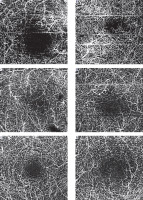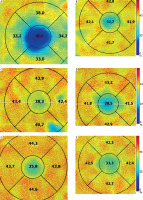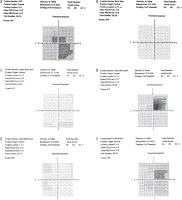INTRODUCTION
In 1962 Cibis became the first ophthalmologist to use silicone oil (SO) as tamponade without vitrectomy for inoperable retinal detachment (RD). Afterwards silicone oil injection with vitrectomy was used for RD with proliferative vitreoretinopathy. The use of silicone oil was subsequently associated with reported complications. Therefore many ophthalmologists started to use long acting gases as tamponade. The common complications of SO are emulsification, glaucoma, cataract and keratopathy. Apart from them there is an increasing number of reports describing unexplained visual loss due to SO tamponade [1-4]. It occurs mainly in RD with macula-on and up to 30% of patients with good preoperative visual acuity lose their vision due to SO tamponade without a clear explanation [5]. Initial reports noted the loss of vision just after removal of silicone oil tamponade [1, 6]. Afterwards some authors reported this phenomenon while the silicone oil was still in place [2, 3].
Recently the optical coherence tomography-angiography (OCTA) macular perfusion changes in patients with silicone oil related visual loss were described by Ma et al. This study suggested that the macular ischemia in the superficial plexus took place due to tamponade [7]. In our study OCTA was also used to analyze the macular microcirculation in 3 cases of unexplained visual loss due to silicone oil tamponade performed for retinal detachment.
Subjects and methods
Three patients with unexplained visual loss after the use of silicone oil tamponade are presented in this retrospective, cross-sectional study (the fellow eye with normal macular microcirculation serves as a control eye). The patients experienced RD between 2018 and 2021. Pars plana vitrectomy (PPV) with silicone oil injection (silicone 1300 centistokes, Arciolane, Arcad Ophta, France) as a initial procedure was performed (Table I). Postoperatively the patients were followed up and the retina was on. Silicone oil removal was performed by active vacuum with BSS-air exchange until there were no significant oil remnants. The follow-up visits took place at 1 day, 7 days, 1 month, 2 months, 3 months and 1 year. The anterior and posterior segment examination, intraocular pressure, OCT, OCTA, fluorescein angiography and central perimetry were performed.
Table I
Details of surgical procedures
SOCT Revo 130 Nx, Optopol Technology Sp. z o.o., Poland, was used to determine the thickness of the ganglion complex cell and obtain OCTA images of the macula. For OCTA images, the macular region of 3 mm × 3 mm was scanned (512 scans × 512 scans). It was centered on the fovea and it comprised the foveal avascular zone (FAZ) and parafoveal zone. Retinal scans underwent automated segmentation into the superficial capillary plexus and deep capillary plexus. The FAZ borders of the deep retinal plexus were automatically or manually redrawn to avoid any mistake. Typically FAZ borders of the deep plexus are less well defined in comparison to the superficial plexus. The vascular densities of the macular region were automatically calculated by software. Only OCTA images with the highest quality index (8-10) were selected.
Verbal informed consent was obtained from all patients who agreed to publish their clinical data.
CASE REPORTS
Two patients experienced severe visual loss during the silicone oil tamponade and one after silicone oil removal. Their visual acuity did not improve during the follow-up period (Table II). No history of anisometropia, intraoperative complication, or media opacity was found. The evaluation of the retinal capillary layers, especially the deep retinal plexus by OCTA, showed the increased FAZ at the deep retinal plexus and the decrease of the density of retinal capillaries around the FAZ (Figures 1 and 2). Macular OCT was normal except for the decrease of GCC thickness. Macular visual field confirmed central scotoma within 4° (Figure 3). The fellow eyes were normal with visual acuity of 1.0 (Snellen).
Table II
Summary of patients
Figure 1
OCTA of deep retinal plexus of 3 mm × 3 mm: FAZ of deep retinal plexus of patient 1: A) affected eye, B) fellow eye; patient 2: C) fellow eye, D) affected eye; and patient 3: E) fellow eye, F) affected eye

Figure 2
OCTA 3 mm × 3 mm: Density of capillaries of deep retinal plexus of patient 1: A) affected eye, B) fellow eye; patient 2: C) fellow eye, D) affected eye; and patient 3: E) fellow eye, F) affected eye

Figure 3
Central scotoma of patient 1: A) affected eye, B) fellow eye; patient 2: C) fellow eye, D) affected eye; and patient 3: E) fellow eye, F) affected eye; perimetry of macula threshold, Carl Zeiss Meditec

Patient 1
He had RD with macula on. His past medical history was notable for diabetes (on oral medication with no diabetic retinopathy), stable hypertension and coronary disease with myocardial infarction in 2013. He had no history of eye disease except myopia of –4 Dsph. PPV with SO injection was done in 2020. The retina was re-attached. During the SO tamponade period his best corrected visual acuity (BCVA) varied from 0.5 to 0.8 (Snellen). Surprisingly, BCVA decreased to 0.08 without any explanation at the 13-week follow-up visit when the SO was still in place. After the silicone oil removal the retina was on and his BCVA was 0.04. It did not improve until 1 year after silicone oil removal. During the entire observation period the macula was never detached.
Patient 2
The patient had RD with partial macula off. His past medical history was notable for diabetes (on oral medication with no diabetic retinopathy) and hypertension. PPV with SO injection was performed. During SO tamponade at the 1-month follow-up visit his BCVA was 0.5 and at the 2-month follow-up visit his BCVA was 0.4. The patient presented one year later (lost to follow-up due to myocardial infarction and misunderstanding about the necessity to remove the SO) with VA 0.04. This visual loss was believed to be due to advanced posterior subcapsular cataract as the retina was on. However, after the cataract operation and the silicone oil removal his BCVA was 0.06 with macula on.
Patient 3
The patient had RD with macula off. His past medical history was notable for hypertension and gout. PPV with SO injection was performed. Postoperatively the retina was reattached and BCVA was 0.2. After 2.5 months the SO removal was performed and VA initially dropped to 0.1 and subsequently to 0.04 without re-detachment of the retina.
DISCUSSION
Although the three patients described above are examples of RD with different status of the macula (on, partially off and completely of), all of them experienced loss of vision due to SO tamponade. Patients 1 and 2 lost their vision during tamponade and patient 3 after removal of tamponade. Patient 3 complained of worsening of his vision during the tamponade and hence his tamponade was removed faster. Therefore in all three patients the vision loss is likely to have the same pathophysiological mechanism. Several theories have been postulated about such a mechanism but none has been proven. The phototoxic damage theory, lutein and zeaxanthin theory and the vitreous potassium sink theory have already been described. The most recent theory focuses on low weight molecular components (LMWC) of SO. During SO production such molecules are made and each SO contains some of them, even after good purification. These molecules were tested in vitro and no acute retinal toxicity was found; however, chronic toxicity is unknown.
With the recent use of OCTA we can analyze macular capillaries at different levels. Ma et al. found macular perfusion changes confirming the decrease of vessel densities of the superficial retinal plexus in the case of visual loss related to silicone oil [7]. This study postulated that the above changes are due to mechanical compression by oil in the case of the patient’s prone position.
In our study a decrease of foveal densities was found in the superficial plexus in patient 1 only, but density changes were present in the deep retinal plexus in all three patients. Apart from that, all three patients had a significantly enlarged FAZ area in the deep retinal plexus (Table III). These findings could support the ischemic origin of silicone oil visual loss. Recent data showed that the deep FAZ area had a strong correlation with retinal sensitivity and visual acuity [8, 9]. As the ischemic changes occur mainly at the deep retinal plexus the fluorescein angiography did not show them.
Table III
Quantitative data of FAZ area
In the small aqueous retro-oil space (between the oil and the fovea), there are circulating LMWC, IL6+ and TNF-α. The interaction between them might have a chronic negative effect on the auto-regulation of foveal retinal capillaries. The foveal zone with its specific architecture at the center including only 4 layers and foveal capillaries located in the outer plexiform layer could be vulnerable. The pericytes of retinal capillaries regulating vascular tone are under the influence of its microenvironment, including soluble vasoactive substances [10, 11]. As a result, some capillaries could close, leading to ischemia, and gradually the metabolism of photoreceptors/outer nuclear layer of the fovea may be damaged irreversibly. Also, systemic diseases such as diabetes even without any sign of retinopathy can perhaps make these capillaries more vulnerable to the SO tamponade. This was the case for patients 1 and 2, who had diabetes type 2 with good control of glycemia (no retinopathy). In this study all three patients were being treated for hypertension (no retinopathy). In addition, patient 2 experienced myocardial infarct during SO tamponade. Normally retinal hemodynamic is self-regulated and independent from the systemic circulation, and a recent study did not find any significant association between retinal vessel density and cardiac hemodynamic variables [12]. If myocardial infarct had influenced macular perfusion in patient 2, both eyes (with SO and without SO) would have had similar changes in OCTA, which was not the case. On the other hand, some impact of myocardial infarct cannot be completely excluded.
All patients experienced transient IOP spikes before removal of the silicone oil. These IOP spikes were managed with local treatment. Patient 1 received timolol with brimonidine and dorzolamide, patient 2 received no treatment and patient 3 received timolol with dorzolamide. As a preventive measure the treatment was continued until SO removal. None of the patients presented elevated IOP after SO removal. The episodically elevated IOP corresponds to findings from the study by Marti et al., which suggested that the increase of intraocular pressure is a risk factor for the vision loss related to silicone oil [13]. OCT of RNFL of all three patients was within normal limits and visual fields did not have any typical glaucomatous scotomas.
The long duration of tamponade is another risk factor reported in the literature [5]. In our study only patient 2 had silicone oil more than 1 year because he did not come for the follow-up visit as planned (Table I).
All three patients had decreased ganglion cell complex thickness as reported by Christensen et al. [14] and all suffered from decreased central retinal sensitivity. The central scotoma was small but very significant (Figure 3). This kind of central scotoma has already been described by Herbert et al. [2] and it did not correspond to the typical glaucoma’s scotoma.
Patients 1 and 2 had high axial myopia, which raises the question of whether high myopia is a risk factor. It has been suggested that short and long axial length eyes have worse retinal microcirculation [15], and in turn these eyes could be more sensitive to SO tamponade.
The unexplained visual loss raises at least three open questions. Firstly, does the degree of loss of vision correspond proportionally to the increase of FAZ area of the deep retinal plexus, as this report may suggest? Secondly, why is the unexplained visual loss much less frequent with gases [16]? Even long standing gas tamponade has shorter duration than silicone oil, so perhaps the harmful effect of the molecules included in the aqueous space between the fovea and the bubble of the tamponade is less damaging. Lastly, are there any predisposing genetic factors including high myopia which make the foveal zone more vulnerable to SO?
The low number of patients, lack of OCTA examination preoperatively for macula-on of patient 1 and the long interval between follow-up visits of patient 2 are major limitations of this study. In addition, OCTA is very sensitive to any media opacities, so great care is needed to obtain the optimal images to avoid misleading results.

 POLSKI
POLSKI




